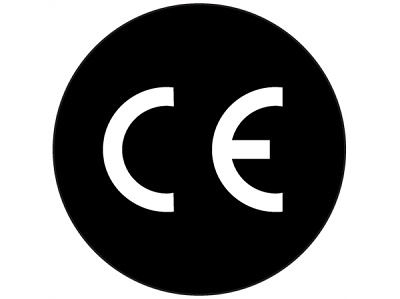
The self-adhesive CE labels that we sell here at Label Source are made of high-quality vinyl with a laminated surface for added durability. They are waterproof, weatherproof, and rub test compliant; these are top-quality labels in all respects, and they are ideal for marking all kinds of different machines, instruments, and pieces of equipment.
What does the CE mark mean?
CE stands for 'Conformité Européenne' - that's French for 'European Conformity'. The symbol shown above, which can be found on a huge variety of different products, essentially means that the item in question conforms to European standards and can be sold within the European Economic Area (EEA).
Is the UK still part of the EEA?
At time of writing, the United Kingdom is still a full member of both the European Union (EU) and the European Economic Area, meaning that many products are still required to bear the CE symbol if they are to be sold here. As you are probably aware, the British people voted to leave the EU in June 2016; however, this does not necessarily mean that the country will also leave the EEA.
Much of the Brexit debate has revolved around the question of whether we are in for a 'soft' Brexit or a 'hard' Brexit. Those in favour of a hard Brexit effectively want the UK to sever all ties with Europe, including the EEA, while advocates for a softer Brexit have suggested that Britain could remain within the European 'free trade zone' even after exiting the European Union proper. (It's likely that this will only be an option if the UK makes some concessions to the EU, e.g. on immigration / freedom of movement).
It is currently unclear whether or not CE labels will continue to be a mandatory presence in British stores for the long term. However, for the time being, the UK is still bound by the same legislation as before the EU referendum, and so British retailers will still be seeing CE symbol on a regular basis for at least a little while yet.
Our CE labels are ideal for machinery and equipment of all sizes. Click here to order your CE symbol labels from the Label Source website.
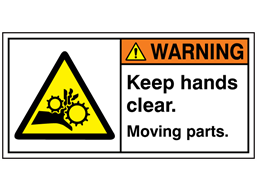
A week has gone by, and we have yet another story to bring to you of a firm being fined for poor safety procedures. It has been reported by WirralGlobe that Cammell Laird have been fined £400,000 for safety failings, after a worker suffered serious injuries whilst carrying out repair work at the Birkenhead shipyard. The 59-year-old from Ellesmere Port, Cheshire, sustained fractures and crush injuries to his right hand in the incident on July 20 last year, and the accident had made him unable work for 5 months, but has now returned.
The incident was investigated by the Health and Safet Executive (HSE) which prosecuted Cammell Laird Shiprepairers and Shipbuilders for serious safety failings. Liverpool Magistrates Court heard this week that the worker was repairing a lathe at the time of the incident. Whilst completing the repair he noticed that the shafts and couplings were dirty. In order to clean these components, he wrapped emery cloth around the lead screw and switched the lathe on. As the machine run, his right hand was pulled in to the moving parts, resulting in his hand being crushed.
A system of lock off, which would of prevented reconnection of the power to the machine, had been identified and was outlined in the written health and safety management system; however, it had not been properly communicated to employees or implemented. Cammell Laird pleaded guilty to breaching section 2(1) of the Health and Safety Work Act 1974 and were fined £400,000, and ordered to pay costs of £7,683.
Health and Safety should be a concern for any organisation. It is the responsibility of the business owner to ensure to carry out a thorough risk assessment and to ensure that all measures possible have been taken to minimise the risk of someone coming to harm at your workplace or as the result of your operations.
To ensure that a similar incident like this one doesn't happen to you, we stock a fantastic selection of Safety Lockout Labels & Signs, as well as a range of Moving Parts Warning Signs.
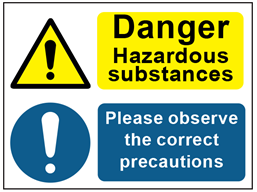
PP Construction Safety has reported that Martin Baker Aircraft Company Ltd - an ejector seat manufacturer - have been fined £800,000 after three workers developed debilitating lung conditions. The three engineering operators developed extrinsic allergic alveolitis after being exposed to the mist of working metal fluid for a large number of years. The lung condition, also known as hypersensitivity pneumonitis, is the body's allergic reaction to breathing in a substance and symptoms include coughing, shortness of breath and joint pain.
The workers had served for the company for more than 20 years, and were exposed to the working metal fluid mist for at least three years. The fluid is used as a lubricant and coolant in engineering processes. During these processes the fluid creates a mist, which in this particular case it has been inhaled by roughly 60 workers. One of the workers has been seriously affected by this incident, and he is now virtually paralysed by this illness. Another will never be able to work with the fluid again - a key material in the engineering industry. And the final worker must have measures in place to ensure he never comes into contact with the substance again.
HSE investigators found that the measures in place within the factory to control the exposure of the mist were inadequate. The company had failed to put in place a system of clearing away the excess fluid or providing extraction to prevent the build-up of the mist. There were also failings in the provision of health surveillance, which should have identified the issue early enough to ensure the company were able to put in place and monitor any appropriate safety measures.
The company have pleaded guilty and were fined £800,000 and ordered to pay costs of up to £36,912.36.
To ensure a similar incident doesn't happen to your company, ensure that there are suitable COSHH Signs have been put in place. To view our range of COSHH labels, click here.
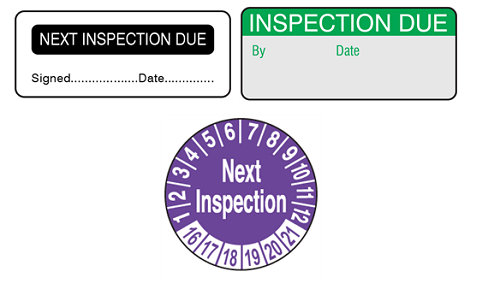
It's essential that your equipment and tools are regularly inspected to ensure that they are in safe working order. However, when you're always busy working it can be difficult to remember when the next inspection is due. This is where we can help! Here at Label Source we stock a range of Next inspection Labels to remind you when a piece of equipment or tool needs to be inspected, so when that tool needs to be inspected, you can have it ready on the day. These labels come in a range of styles and can be pretty much applied to any surface.
Here are some of the Next inspection labels we have to offer:
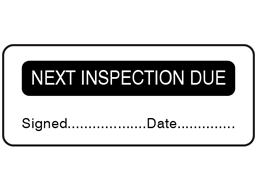
Next Inspection Due Label
Write on surface label
Material: Polyester, Self-Adhesive, Print receptive
Size: 20mm x 50mm
Supplied in packs of 100 labels
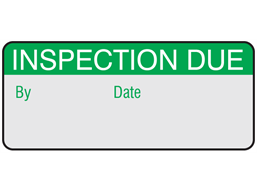
Inspection Due Aluminium Foil Labels
Material: Aluminium Foil, with self adhesive backing
Size: 16mm x 38mm
Supplied in rolls of 250 labels
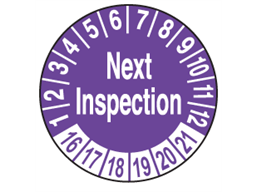
Next inspection Due Month and Year Label
Material: Choice of Self Adhesive Vinyl or Tamperproof Self Adhesive Vinyl
Size: Diameter of 15mm, 25mm or 40mm
Supplied in packs of 250 labels
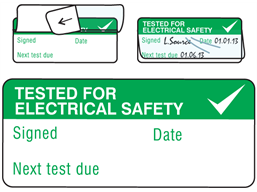
Tested for electrical safety, next test due write and seal labels
write and seal label
Scratch and Chemical resistant
Waterproof
Size: 16mm x 38mm
Material: Self adhesive vinyl, with part attached clear laminate
Supplied in rolls of 500 labels
If you wish to view our entire range of Next Inspection Labels, please click here.
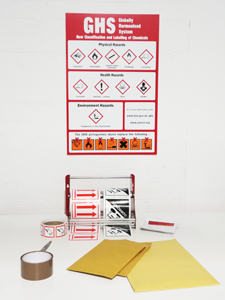
If you work with any dangerous chemicals, our range of Printable GHS Labels will allow you to indetify any hazards and minimise the possibility of an accident GHS stands for Globally Harmonised System, and this system is the international standard for chemical labelling. GHS was created by the United Nations to ensure that any dangerous chemicals that may pose a risk to an individuals health and safety would be labelled in the same way all over the world, and it now supercedes other EU classification standards.
Here at Label Source we have an excelllent selection of GHS Hazard Labels that will cover all possible bases, and with GHS regulation being legallybinding here in the UK. these labels will ensure that your workplace is both safe and legal. Our labels are available in a selection of sizes. Here is a handful of GHS-compliant Hazard labels we have to offer:
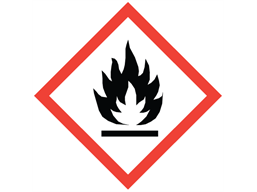
GHS Flamable Hazard Label
Used to mark any dangerous materials that are potentially flammable chemical substances or mixtures.
Waterproof
Chemical and abrasion resistant
Available in eight sizes
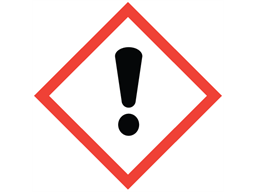
Harmful/Irritant Hazard Label
Used to mark any harmful or irritant chemical substances or mixtures.
Waterproof
Chemical and abrasion resistant
Available in eight sizes
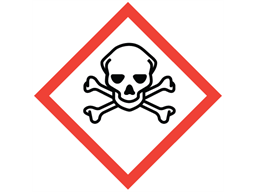
Toxic Hazard Label
Used to mark potentially toxic chemical substances or mixtures.
Waterproof
Chemical and Abrasion Resistant
Available in eight sizes
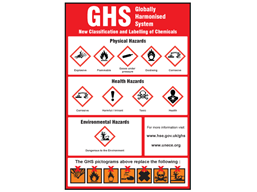
GHS Classification Sign
Used to outline the categories in physical, health and environmental hazards.
Available in two sizes
Made from rigid plastic
To view our entire range of Printable GHS Labels, click here.